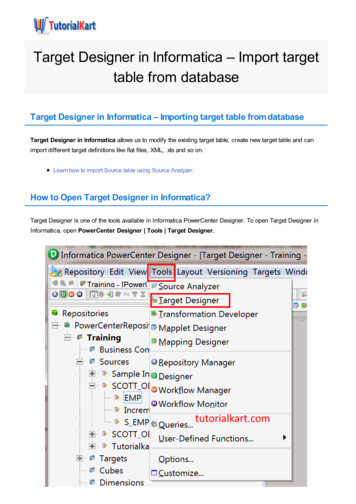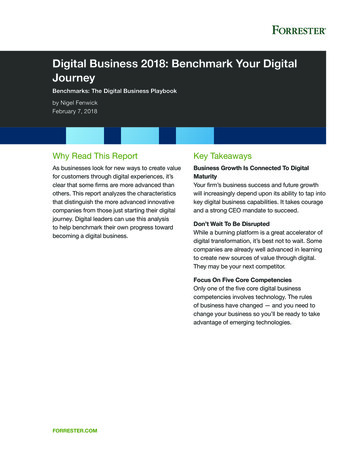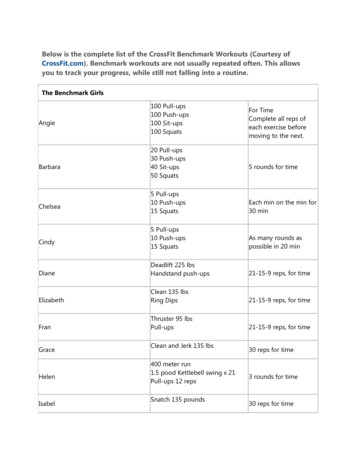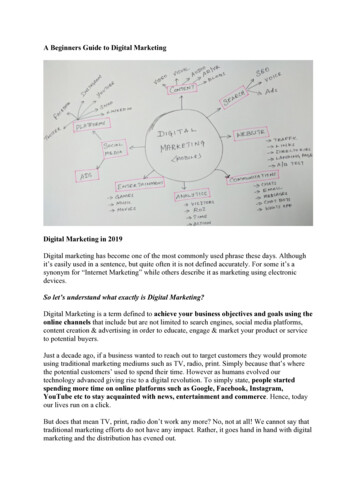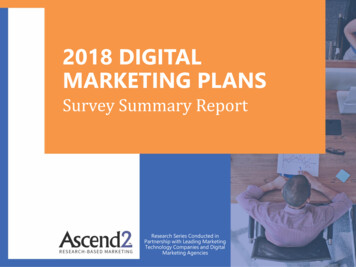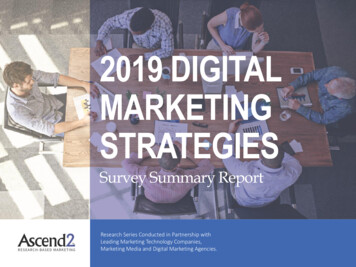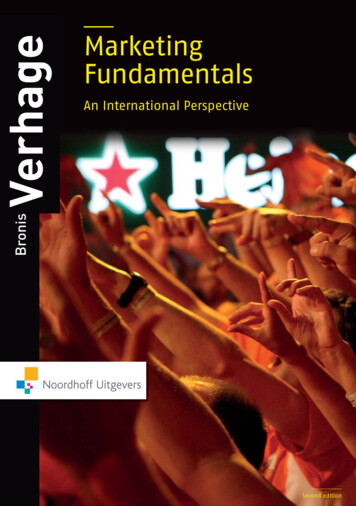
Transcription
DIGITAL MARKETING SKILLSBENCHMARKJANUARY 2022in association with
CONTENTSIntroduction3Background4Intern43About the Benchmark5Assistant/Graduate44Summary Results6Executive45Digital Disciplines Breakdown8Manager46Seniority Breakdown42Digital Disciplines Quintile Breakdown10Head of Department47Industry ve14Final Thoughts51Beauty and Cosmetics15Charity16Construction and Property17Consultancy18Consumer Goods19Ecommerce/Online20Education and Training21Electronics and Engineering22Events and Conferences23Fashion24Financial Services25Food and y/Telecoms30Leisure/Entertainment/Sport31Legal and Accountancy32Luxury Goods33Manufacturing34Media and Publishing35Pharmaceutical36Professional Services37Public Sector38Recruitment and HR39Retail40Travel/Tourism/Hospitality/Catering412
Target InternetTHE DEMAND FOR MARKETERSWITH A MORE GENERALMARKETING SKILLSET REMAINS.RECRUITMENT IS REPORTING ANOTABLE INCREASE IN DEMANDFOR MARKETING MANAGERS ANDMARKETING EXECUTIVES The latest Benchmark results are a reflection of the uncertain environment we are currently operatingin, where nothing remains the same and change is now expected as opposed to anticipated. As theresults indicate, digital marketing skills look to have declined since the last report, despite technologycontinuing to evolve and levels of data increasing at a staggering rate. Add to that the world goingvirtual and digital channels becoming in some cases our only means of engagement, this decline isn’twhat you would expect and raises many questions.As was noted by CIM’s CEO Chris Daly, marketing’s position was elevated in 2020. With an increasedpressure to retain customer engagement, keep brands front of mind and alter products and servicesto meet a world in lockdown, came a need for a wider more generalist marketing skillset. This wasfurther compounded with many organisations having to make people redundant or put them onfurlough. With more senior roles having to take on more of the day-to-day tasks, this could offersome explanation as to why the report is showing an increase in digital training at the senior end. Asorganisations are now looking forward, it would seem the demand for marketers with a more generalmarketing skillset remains. Recruitment is reporting a notable increase in demand for marketingmanagers and marketing executives. It is of course still too early to say whether this trend is longterm or if the pace of technological change will force our focus back onto digital and see a return indemand for digital training and indeed more specialist roles.Gemma Butler, Marketing Director,Chartered Institute of Marketing3
BACKGROUNDThis year we have compared data to both 2020 and to the original 2018 data, to allow us tosee changes since the benchmark began. We have also covered more industries, as well asbroken down the data into quintiles to understand the range of skills within each industryand within the overall results. Over 7200 people have now been tested for the benchmark,making it the largest and most thorough digital marketing skills benchmark globally.Digital has fundamentally changed the way we buy, makeand a culture of ongoing learning needs to be developeddecisions, and interact with one another. As such, it hasby organisations and adopted by individuals. Culture is anbecome an essential element of not only any marketingessential element of the solution to any skills gap, as simplystrategy but of any organisational strategy. The environmentproviding learning opportunities and training does notof constant change has led to a huge skills challenge fornecessarily lead to its adoption and usage.individuals and organisations. Combine this with a vastlychanged working environment caused by the pandemic, andA starting point to addressing this skills challenge is towe have a recipe for some big challenges.understand where our skills gaps lie and how this differsbetween industries, roles, and seniorities. The Digital SkillsThe ongoing pace of change means a straightforwardBenchmark aims to be that starting point, to inform theprocess of ‘one-off’ training is no longer fit for purpose.conversation and drive an ongoing skills improvementYou can no longer expect to sit on your current skillsetagenda.and progress. Skills need to be updated on an ongoing basis,4
ABOUT THE BENCHMARKThe Digital Marketing Skills Benchmark is the only study of its type and scale that looksat skills across such a wide range of industries and levels of seniority. Rather than beingopinion based like many other studies, the core of the benchmark assesses the skills ofthousands of individuals (you can read more about the methodology below).This approach allows for a frank look at digital marketingskills in the UK market and identifies a range of skillsgaps and challenges that need to be overcome in order forbusinesses to thrive. The benchmark combines raw dataon where skill levels currently lie, whilst also providinginsights and opinions on what this means in practice. Theaim of the benchmark is to help industry make informeddecisions about improving skills and to reinforce the needfor a culture of ongoing learning in all organisations. Thebenchmark, now in its 3rd edition, also compares how skillshave changed over the past three years, and analyses whatA Note on QuintilesA new addition to the benchmark is the breakdown ofindustry results into quintiles. This means we can see notonly the average scores by industry but also understandwithin each industry where the range of skills are focussed.The quintiles breakdown shows what percentage of peoplesit within each of the 5 segments across a 0-100% range.Identifying industries with the highest percentages in thetop two quintiles allows us to identify industries that aredoing particularly well (and those that aren’t).we can learn from our progress (and lack of it in manycases).The benchmark has now tested over 7200 people’s digitalmarketing skills. The latest iteration allows us to comparethe progress made over the last three years. The questionswere taken from a bank of questions on each topic thattested both tactical and strategic knowledge. Thesequestions were weighted according to difficulty/level ofspecialism, and a percentage score was calculated out of apossible 100%. The benchmark has been tested in a rangeof commercial organisations before being made morebroadly available. This confirms the results are alignedwith the reality of an individual’s skills. Questions areregularly updated to reflect the latest industry best-practiceand are aligned with the Chartered Institute of Marketingprofessional standards and qualifications.THIS THIRD EDITION OF THEDIGITAL SKILLS BENCHMARKHIGHLIGHTS SOME VERYSIGNIFICANT SHIFTS IN SKILLS INTHE PAST YEAR AND EXPLORESTHE IMPACT THIS WILL HAVE ONORGANISATIONS OF ALL TYPES.Target Internet Digital Marketing Skills Benchmark 20215
SUMMARY RESULTSThe latest Digital Marketing Skills Benchmark should be a wake-up call for manyorganisations. Marketing technology, search engines and social media platforms continueto innovate at pace, and consumer use of digital channels has increased, but skills have notbeen a focus during the pandemic. This has led to digital marketing skills stagnating ordeclining over the past year in almost all sectors and at all levels of seniority.Digital skills are going backwardsOverall, we have seen stagnation or a decline across themajority of digital marketing disciplines between 2020 andThe majority of people are in the lowertwo quintiles in the majority of digitalmarketing disciplines2021. This is perhaps surprising given the interest in onlineOnce we break down skills within a particular disciplinecourses and learning across the Covid impacted workforce.within an industry, we can see how many people in thatHowever, with marketing technology still moving at pacegroup fall in the lower and higher quintiles. The majorityalong with people’s work and conference and trainingof people fall into the lowest two quintiles in all but twoattendance declining, this is perhaps less surprisingdisciplines.Marketing fundamentals have improvedContent Marketing has seen a decline inskills and has one of the largest groups inthe lowest two quintilesThe only discipline to see any significant improvementin skills was ‘General Marketing’ that includes the coreprinciples of marketing. This may indicate a ‘back toContent marketing saw one of the largest dips in skills offundamentals’ approach, or reliance on previously learntall disciplines as well as seeing one of the largest groupstechniques in challenging times. However, this improvementof people in the lowest two quintiles. As reliance on onlinein understanding of the core principles of marketing shouldcontent has increased, volumes of content have gone up, buthave a positive impact on all digital marketing output.content marketing skills have not.Skills are more aligned with seniority, butthere is still a problem in senior rolesAnalytics & Data has seen the largestdecline in skillsFor the first time in the skills benchmark we are seeingAs the overall complexity of digital marketing continues tocloser alignment between seniority and level of digitalgrow, and with new analytics options like Google Analyticsmarketing skills, that is, the more senior, the better the4, and changes in cookie rules, a fallback in Analytics &skills in many cases. However, this should not be an areaData skills is easy to explain but worrying for the ability offor celebration as all levels of seniority have seen skillsmarketers to analyse and constantly improve their work.fall back since 2020, at various levels, in order to give thisalignment. There is also a stagnation of skills once peopleachieve management level roles, meaning those peopleresponsible for managing teams and agencies, are notimproving their skills.Agencies have scored well overallcompared to average and have thelargest group of people within the topquintileAlthough agencies saw skills drop off in a comparable wayto many other sectors, they are scoring well overall andhave a higher percentage of respondents in the two highestquintiles of results than any other group.6
MARKETING TECHNOLOGY,SEARCH ENGINES AND SOCIALMEDIA PLATFORMS CONTINUE TOINNOVATE AT PACE, AND CONSUMERUSE OF DIGITAL CHANNELS HASINCREASED
DIGITAL DISCIPLINES BREAKDOWNIn all disciplines, with the exception of one area, there has been no significant improvementin skills. In fact, in all but three disciplines, skills have stayed static or indeed gonebackwards.Only ‘General Marketing,’ which covers marketingSocial Media has fallen back 2%, Content Marketing 4%fundamentals and models has improved significantly withand Analytics & Data a worrying 6%. The social mediaa 7% uplift. It is very positive to see a better understandingindustry has continued to move at pace in the last year,of marketing fundamentals, and this should have a positivewhilst training, conferences and other face-to-face learningimpact on all other areas of digital marketing output. Emailinterventions were cut back dramatically, potentiallyand PPC saw a very small 1% improvement.explaining this movement backwards in skills. As the levelof digital marketing content produced continues to grow, aStrategy, Ecommerce, Online Advertising and Usabilitymovement backwards in content marketing skills will nothave stayed static with no change in results since last year.help with the quality of content being produced. As theMobile and SEO have seen a minimal movement backwardsoverall complexity of digital marketing continues to grow,with a 1% reduction.and with new analytics options like Google Analytics 4, andchanges in cookie rules, a fallback in Analytics & Data skillsis easy to explain but worrying for the ability of marketersto analyse and constantly improve their work.All Industries OverviewUsabilityAnalytics and DataContent Marketing100%80%60%Social MediaDigital Strategy40%20%SEOEcommerce0%PPCEmail MarketingOnline Advertising20208Mobile MarketingGeneral Marketing2021
All Industries change over timeAnalytics & DataContent MarketingDigital Strategy29%24%34%-6 compared 2020-4 compared 20200 compared 2020iiiEcommerceEmail MarketingGeneral Marketing37%49%54%0 compared 2020 1 compared 2020 7 compared 2020iiiMobile MarketingOnline AdvertisingPPC28%31%32%-1 compared 20200 compared 2020 1 compared 2020iiiSEOSocial MediaUsability33%32%28%-1 compared 2020-2 compared 20200 compared 2020iiiiTarget Internet Digital Marketing Skills Benchmark 2021Three year trend9
DIGITAL DISCIPLINE QUINTILE BREAKDOWNThe new charts below show what percentage of people sit within the top and bottomquintiles within each digital marketing discipline. This allows us to see beyond the averagescores and understand what percentage of people have a strong understanding, and whatpercentage are struggling.Quintiles 1 and 2 show us the weakest levels of knowledgeWe also see 75% of people falling into the lowest quintilesand quintiles 4 and 5 the highest levels. We can see that thein the more technical areas of Mobile Marketing, again amajority of people sit in the lowest quintiles for all topicsproblem with mobile usage increasing.except General Marketing and Email Marketing, in line withthe benchmark’s overall results. However, when we lookBoth Usability and Analytics & Data show 67% of peoplemore closely, we can see some interesting insights.falling into the lowest quintiles. These are possibly themost worrying results within the benchmark, due to theA high level of comfort with Email Marketing is great, butimpact poor analytics skills and poor usability can have onhistorical data tells us that just because people understandall aspects of digital marketing. Bear in mind that topicsa channel, doesn’t mean they always apply their knowledgelike personas and user journey mapping fall into Usability,to deliver best practice activity. Comfort with email alsomeaning that these key principles will be within this lowmeans it is easier than ever to send email campaigns,skill level.creating even more noise in an already noisy space.75% of people fall into the lowest quintiles for ContentMarketing. This is particularly problematic when more andmore content is being created, and clearly, that content willnot be following best-practice in many cases.Quintile Distribution100%This chart contains the percentage scoredistribution for all industries. We have groupedthe first and second quintiles (percentage of75%respondents that achieved the lowest scores0-40), as well as the fourth and fifth quintile50%(percentage of respondents that achieved thehighest scores 60-100)25%0%1st & 2nd Q103rd Q4th & 5th Q
Analytics & DataContent MarketingDigital %0%1st & 2nd Q3rd Q4th & 5th Q1st & 2nd Q3rd Q4th & 5th Q1st & 2nd Q3rd QEcommerceEmail MarketingGeneral 0%0%1st & 2nd Q3rd Q4th & 5th Q1st & 2nd Q3rd Q4th & 5th QMobile MarketingOnline 25%0%0%0%1st & 2nd Q3rd Q4th & 5th Q1st & 2nd Q3rd Q4th & 5th Q1st & 2nd Q3rd Q4th & 5th Q1st & 2nd Q3rd Q4th & 5th Q3rd Q4th & 5th QSEOSocial 25%0%0%0%1st & 2nd Q3rd Q4th & 5th Q1st & 2nd Q3rd QTarget Internet Digital Marketing Skills Benchmark 20214th & 5th Q4th & 5th Q1st & 2nd Q11
INDUSTRY BREAKDOWN
AGENCYUsabilityAnalytics and DataContent Marketing100%60%Digital Strategy40%sectors. However, we have stillseen significant declines in overallknowledge levels in most disciplines20%SEOlevel of knowledge of digital wasbetter than most other industry80%Social MediaAs you would hope, agencies’ generalEcommerce0%in the last year, again indicating thechallenge of staying up to date inan increasingly complex and fastchanging world. However, when wePPCEmail Marketingbreak down the skills across the sector,the Agencies sector did very welland has 24% of its workforce in theOnline AdvertisingMobile MarketingGeneral MarketingAll Digital DisciplinesDisciplineAnalytics & DataContent MarketingDigital StrategyEcommerceEmail MarketingGeneral MarketingMobile MarketingOnline AdvertisingPPCSEOSocial MediaUsabilitytop two quintiles, one of the highestconcentrations of top scores of anyindustry.AgencyResultTrend35%-6 compared 202029%-2 compared 2020Quintile distribution41% 1 compared 2020100%45%75% 2 compared 202058%-1 compared 202056% 8 compared 202028%-7 compared 202040%0 compared 202037% 1 compared 202038%-4 compared 202031%-6 compared 202032%-3 compared 2020Target Internet Digital Marketing Skills Benchmark 202150%25%0%1st Q2nd Q3rd Q4th Q5th QThis chart contains the percentagescore distribution across each quintilefor Agency. The first quintile indicatesthe percentage of respondents thatachieved the lowest scores (0-20) andthe fifth indicates the percentage ofrespondents that achieved the highestscores (80-100)Benchmark up to 10 membersof your team for free.Email Susana:susana@targetinternet.com13
AUTOMOTIVEUsabilityAnalytics and DataContent Marketing100%60%Digital Strategy40%improvement has been in ContentMarketing. The industry has alsoshown further growth in Email skills,20%SEOsome improvements (and somechallenges as well). The most notable80%Social MediaThe automotive industry has seenEcommerce0%reflecting anecdotal evidence of overreliance on this channel still in theindustry. The biggest drop in skills hascome from SEO, which will need toPPCEmail Marketingbe addressed if the growth in ContentMarketing skills is to be fully utilised.Like many industries, skills haveOnline AdvertisingMobile MarketingGeneral MarketingAll Digital Disciplinesdropped slightly as some disciplineshave become more complex and thepace of change continues. AutomotiveAutomotivehas 23% of its workforce in the toptwo quintiles, making it one of theDisciplineAnalytics & DataContent MarketingDigital StrategyEcommerceEmail MarketingGeneral MarketingMobile MarketingOnline AdvertisingPPCSEOSocial MediaUsability14Result31%Trendtop three industries for percentage ofpeople in these top groups.-4 compared 202027% 5 compared 202029%Quintile distribution-5 compared 2020100%42%75% 8 compared 202054% 5 compared 202041% 1 compared 202028% 3 compared 202030%-6 compared 202035%-3 compared 202034%-7 compared 202034%-2 compared 202029% 4 compared 202050%25%0%1st Q2nd Q3rd Q4th Q5th QThis chart contains the percentagescore distribution across eachquintile for Automotive. The firstquintile indicates the percentage ofrespondents that achieved the lowestscores (0-20) and the fifth indicatesthe percentage of respondents thatachieved the highest scores (80-100)Benchmark up to 10 membersof your team for free.Email Susana:susana@targetinternet.com
BEAUTY AND COSMETICUsabilityAnalytics and DataContent Marketing100%and Cosmetics industry in this year’sbenchmark. Whilst seeing skills80%60%Social MediaDigital Strategy40%declining in Social Media, PPC and adramatic drop in General Marketingskills, the industry has bucked the20%SEOIt is a real mixed bag for the BeautyEcommerce0%trend and improved skills in Analytics& Data significantly. The industry alsosaw good improvements in DigitalPPCEmail MarketingStrategy and Content Marketing, beingone of the only industries to showimprovements. Overall Beauty andCosmetics also did well with 22% ofOnline AdvertisingMobile MarketingGeneral MarketingAll Digital DisciplinesDisciplineAnalytics & DataContent MarketingDigital StrategyEcommerceEmail MarketingGeneral MarketingMobile MarketingOnline AdvertisingPPCSEOSocial MediaUsabilityits workforce in the top two quintiles.Beauty and CosmeticResultTrend40% 8 compared 202027% 4 compared 2020Quintile distribution40% 10 compared 2020100%40%75% 1 compared 202046%-2 compared 202034%-12 compared 202023%-4 compared 202035% 5 compared 202030%-4 compared 202037% 7 compared 202037%-2 compared 202028% 6 compared 2020Target Internet Digital Marketing Skills Benchmark 202150%25%0%1st Q2nd Q3rd Q4th Q5th QThis chart contains the percentagescore distribution across each quintilefor Beauty and Cosmetic. The firstquintile indicates the percentage ofrespondents that achieved the lowestscores (0-20) and the fifth indicatesthe percentage of respondents thatachieved the highest scores (80-100)Benchmark up to 10 membersof your team for free.Email Susana:susana@targetinternet.com15
CHARITYUsabilityAnalytics and DataContent Marketing100%60%Digital Strategy40%in Digital Strategy and GeneralMarketing. This reflects an industrythat is making better planned use of20%SEOfocused on Email Marketing skills butthankfully knowledge has increased80%Social MediaCharities seem to still be veryEcommerce0%the opportunities of digital marketing.However, there has been a dip in themajority of skills disciplines, in anindustry that was already performingPPCEmail Marketingpoorly against average. The Charitysector has 16% of its workforce in thetop two quintiles, making it one of theOnline AdvertisingMobile MarketingGeneral MarketingAll Digital DisciplinesDisciplineAnalytics & DataContent MarketingDigital StrategyEcommerceEmail MarketingGeneral MarketingMobile MarketingOnline AdvertisingPPCSEOSocial MediaUsability16lowest performing industries overall.CharityResultTrend27%-7 compared 202019%-4 compared 202034%Quintile distribution 2 compared 2020100%38%75% 4 compared 202053%-4 compared 202053% 12 compared 202024%-3 compared 202024%-6 compared 202026%-2 compared 202029%0 compared 202032%-2 compared 202026% 2 compared 202050%25%0%1st Q2nd Q3rd Q4th Q5th QThis chart contains the percentagescore distribution across each quintilefor Charity. The first quintile indicatesthe percentage of respondents thatachieved the lowest scores (0-20) andthe fifth indicates the percentage ofrespondents that achieved the highestscores (80-100)Benchmark up to 10 membersof your team for free.Email Susana:susana@targetinternet.com
CONSTRUCTION AND PROPERTYUsabilityAnalytics and DataContent Marketingand Property industry has been80%analysed independently in the60%Social MediaDigital Strategy40%benchmark. The industry is againscoring poorly overall against averagein all disciplines but has seen20%SEOThis is the 2nd time the Construction100%Ecommerce0%some improvements in Ecommercecapability. This is indicative of anindustry behind the curve in mostcases. However, it also indicates thatPPCEmail Marketingorganisations in this sector thataddress their digital skills gap havean opportunity to stand out amongstOnline AdvertisingMobile MarketingGeneral MarketingAll Digital Disciplinestheir competitors. Construction andProperty has 17% of its workforce inConstruction and Propertythe top two quintiles, making it oneof the lower performing industriesoverall.DisciplineAnalytics & DataContent MarketingDigital StrategyEcommerceEmail MarketingGeneral MarketingMobile MarketingOnline AdvertisingPPCSEOSocial MediaUsabilityResultTrend29%-6 compared 202024% 2 compared 2020Quintile distribution28%-4 compared 2020100%37%75% 7 compared 202046%-7 compared 202041%-5 compared 202024%-6 compared 202027%-2 compared 202025%-2 compared 202034% 1 compared 202028%-7 compared 202023% 2 compared 2020Target Internet Digital Marketing Skills Benchmark 202150%25%0%1st Q2nd Q3rd Q4th Q5th QThis chart contains the percentagescore distribution across each quintilefor Construction and Property. The firstquintile indicates the percentage ofrespondents that achieved the lowestscores (0-20) and the fifth indicatesthe percentage of respondents thatachieved the highest scores (80-100)Benchmark up to 10 membersof your team for free.Email Susana:susana@targetinternet.com17
CONSULTANCYUsabilityAnalytics and DataContent Marketingsaw a mixed bag of decline and80%improvements across all digital60%Social MediaDigital Strategy40%disciplines but actually still scoredquite poorly against averages evenwhere there was improvement. This20%SEOGenerally, the Consultancy sector100%Ecommerce0%is heavily impacted by what type ofconsultancy these organisations offer,but since digital impacts almost allareas of business, it should be a keyPPCEmail Marketingarea of focus for the Consultancyindustry to improve their digital skills.Consultancy has 19% of its workforceOnline AdvertisingMobile MarketingGeneral MarketingAll Digital DisciplinesDisciplineAnalytics & DataContent MarketingDigital StrategyEcommerceEmail MarketingGeneral MarketingMobile MarketingOnline AdvertisingPPCSEOSocial MediaUsability18in the top two quintiles, puttingit towards the average level of allindustries.ConsultancyResultTrend30%-3 compared 202023%-2 compared 202030%Quintile distribution-6 compared 2020100%42%75% 5 compared 202042%-6 compared 202040%-8 compared 202030%0 compared 202032% 6 compared 202034% 4 compared 202033% 2 compared 202032%-1 compared 202030%0 compared 202050%25%0%1st Q2nd Q3rd Q4th Q5th QThis chart contains the percentagescore distribution across eachquintile for Consultancy. The firstquintile indicates the percentage ofrespondents that achieved the lowestscores (0-20) and the fifth indicatesthe percentage of respondents thatachieved the highest scores (80-100)Benchmark up to 10 membersof your team for free.Email Susana:susana@targetinternet.com
CONSUMER GOODSUsabilityAnalytics and DataContent Marketing100%skills falling back across almost alldigital marketing disciplines with80%60%Social MediaDigital Strategy40%the exception of good improvementsin Social Media and Digital Strategy.However, with so many other areas20%SEOThe Consumer Goods sector sawEcommerce0%falling back, it will be hard to take fulladvantage of these improvements. TheConsumer Goods industry has 18% ofPPCEmail Marketingits workforce in the top two quintiles,putting it towards the lower end of allindustries.Online AdvertisingMobile MarketingGeneral MarketingAll Digital DisciplinesDisciplineAnalytics & DataContent MarketingDigital StrategyEcommerceEmail MarketingGeneral MarketingMobile MarketingOnline AdvertisingPPCSEOSocial MediaUsabilityConsumer GoodsResultTrend31%-2 compared 202020%-6 compared 2020Quintile distribution40% 6 compared 2020100%38%75%-10 compared 202057%0 compared 202037%-4 compared 202033%-1 compared 202032%-4 compared 202030%-1 compared 202033%-5 compared 202034% 4 compared 202026%-9 compared 2020Target Internet Digital Marketing Skills Benchmark 202150%25%0%1st Q2nd Q3rd Q4th Q5th QThis chart contains the percentagescore distribution across eachquintile for Consumer Goods. The firstquintile indicates the percentage ofrespondents that achieved the lowestscores (0-20) and the fifth indicatesthe percentage of respondents thatachieved the highest scores (80-100)Benchmark up to 10 membersof your team for free.Email Susana:susana@targetinternet.com19
ECOMMERCE/ONLINEUsabilityAnalytics and DataContent Marketing100%60%Digital Strategy40%these fall backs was in Social Media,an important channel in regard toEcommerce. The biggest gains were20%SEOseen improvement across all but threedigital disciplines. The biggest of80%Social MediaEcommerce has bucked the trend andEcommerce0%in Content Marketing, which is greatnews for an industry that was underperforming in this area for many years.Although Ecommerce did well againstPPCEmail Marketingaverage, only 18% of its workforce arein the top two quintiles, indicating anextremely broad range of differentOnline AdvertisingMobile MarketingGeneral MarketingAll Digital DisciplinesDisciplineAnalytics & DataContent MarketingDigital StrategyEcommerceEmail MarketingGeneral MarketingMobile MarketingOnline AdvertisingPPCSEOSocial MediaUsability20skills levels in the industry.Ecommerce/OnlineResultTrend28% 2 compared 202025% 7 compared 202028%Quintile distribution 3 compared 2020100%35%75% 1 compared 202041%-3 compared 202045% 7 compared 202024%-3 compared 202030% 2 compared 202029% 2 compared 202032% 2 compared 202026%-6 compared 202025% 3 compared 202050%25%0%1st Q2nd Q3rd Q4th Q5th QThis chart contains the percentagescore distribution across each quintilefor Ecommerce/Online. The firstquintile indicates the percentage ofrespondents that achieved the lowestscores (0-20) and the fifth indicatesthe percentage of respondents thatachieved the highest scores (80-100)Benchmark up to 10 membersof your team for free.Email Susana:susana@targetinternet.com
EDUCATION AND TRAININGUsabilityAnalytics and DataContent Marketing100%60%Digital Strategy40%Email Marketing but struggled in allother aspects of digital. That trendhas continued with improvements20%SEOthat scored well previously intraditional marketing techniques and80%Social MediaEducation was one of several sectorsEcommerce0%in General Marketing but fallen backwithin Email Marketing. Education sawan encouraging 4% improvement inContent Marketing, an area that hadPPCEmail Marketingbeen well below average previously.Overall, still an industry changingradically and potentially beingOnline AdvertisingMobile MarketingGeneral MarketingAll Digital Disciplinesdisrupted by new market entrants.Education and Training has 18% ofEducation and Trainingits workforce in the top two quintiles,putting it towards the lower end of allindustries.DisciplineAnalytics & DataContent MarketingDigital StrategyEcommerceEmail MarketingGeneral MarketingMobile MarketingOnline AdvertisingPPCSEOSocial MediaUsabilityResultTrend30%-3 compared 202026% 4 compared 2020Quintile distribution30%-5 compared 2020100%34%75%-3 compared 202047%-3 compared 202054% 7 compared 202026%50%25%0%1st Q2nd Q3rd Q4th Q5th Q-2 compared 2020This chart contains the percentage28%for Education and Training. The first-1 compared 202032% 2 compared 202031%-2 compared 202035% 1 compared 202029% 2 compared 2020Target Internet Digital Marketing Skills Benchmark 2021score distribution across each quintilequintile indicates the percentage ofrespondents that achieved the lowestscores (0-20) a
The latest Digital Marketing Skills Benchmark should be a wake-up call for many organisations. Marketing technology, search engines and social media platforms continue to innovate at pace, and consumer use of digital channels has increased, but skills have not been a focus during the pandemic. This has led to digital marketing skills stagnating or
